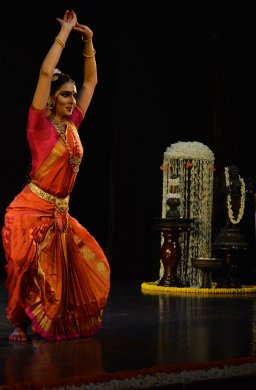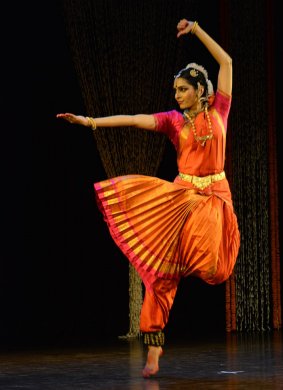
|   |

|   |
Madhura Bhrushundi’s Bharatanatyam recital - Dr. Sunil Kothari e-mail: sunilkothari1933@gmail.com Photos: S Dhillon August 13, 2014 Geeta Chandran presented her disciple Madhura Bhrushundi in her maiden recital under the aegis of her institution Natya Vriksha at Chinmaya Mission Hall on August 9, 2014 at Delhi. As a master of ceremony, Rajiv Chandran has by now earned a formidable reputation. From the entrance, a bevy of young beautiful dancers receiving the invitees, putting kumkum and chandan tilak on forehead, to being escorted to the seat facing an aesthetically decorated stage with flowers and deeplakshmi lamp, everything was spic and span and in order. The brochure with well taken photographs of the dancer and with her guru, giving background of the artist and about Natya Vriksha institution was a delight. Madhura’s training in Bharatanatyam from a young age, even during her parents’ travels in different cities, seems to have continued uninterrupted. When she was in Vadodara, she took lessons from Rema Shrikant and finally settled in Delhi, she came under the tutelage of Geeta. As a matter of fact, Madhura took off one year just to concentrate on Bharatanatyam. Her effort, practice and resultant performance displayed her dedication. Bright in her academic studies, Madhura is planning to go to Warwick University in UK to further her studies in Economics. But prior to that, she determined to master the technique under Geeta’s watchful guidance and perform in public before leaving for studies abroad. Renowned Bharatanatyam exponent Leela Samson was the chief guest. 

Tall and svelte, Madhura has a pleasant stage presence. Opening with Pushpanjali, she displayed understanding of space and clean diagonal lines, basic correct posture and impressed one by executing movements with perfect synchronisation to the accompanying music. She followed it with alarippu which as Leela Samson said in her speech has been of late rarely seen in Bharatanatyam recitals. It was indeed an exquisite piece of choreography. Apparently looking so simple, one marvels at its complex, scientific, precise and aesthetic structure of pure dance. Watching alarippu one feels that one is looking at a mobile piece of architecture, a moving frieze. One can look at the symmetrical reduplication and repetitive parallelism of dance patterns in the alarippu. With repetitions in standing and sitting, repetition of tala units by hands and neck in alternation and unison, one watches in wonder how the circles, semicircles and parabolas of the arm movements terminate in two or three crisp triangular ones towards the close as in some wonderful kolam. Alarippu is so consummately planned that it looks new every time. I enjoyed watching Madhura going through its paces unhurriedly. It was noteworthy to watch late Guru Dandayudhapani Pillai’s jatiswaram, varnam and tillana as taught to Madhura by Geeta. These are rare numbers and reveal the genius of the great guru who had once taught at Kalakshetra. He had choreographed Kuravanjis, taught dancers like Vyjayanthimala and worked in films, His younger brother Dakshinamurthy Pillai taught Geeta his elder brother’s choreographic works. These are revived by Geeta, which is wonderful. Dedicated to Kartikeya, the varnam Samiyai vara solladi depicts the nayika’s request to her friend to convey to her beloved the agony of separation, the long passages of pure dance, interspersed with episodes of how in guise of an old man Kartikeya rescued Valli and married her, the beauteous lord riding his peacock vehicle. The nayika pleads with her sakhi to convey to her lord that this is the time for union and why has he been indifferent. The arrows of Kamadeva showered on her agonise her. The abhinaya was communicative, the nritta was sparkling. Tukaram’s abhang was performed with sensitivity, partly as Madhura is Maharashtrian and follows the import of the song in totality. Tukaram asks Lord Panduranga why he has been playing ‘hide and seek’ with him. If he goes in front, he disappears and when he turns back also, he disappears. Finally the devotee says when the lord resides in his heart, why is he seeking him anywhere else? The singer Venkatesh sang it with feeling, with clear enunciation bringing to the fore the intense desire of the devotee to be with his lord. In Papanasam Sivan’s padam in praise of Lord Shiva, Madhura described the dance of the lord holding several poses competently. The dandapada pose, holding the foot horizontally, was well balanced. The ananda tandava is a favourite among the dancers and Geeta has taught it with great care bringing out its import and iconographic beauty. While introducing the final number tillana in Hindolam, another gem from Dandayudhapani Pillai’s choreographic works, Rajiv spoke of what the legendary Balasaraswati had said in her speech at The Music Academy when she was honoured with Sangeeta Kalanidhi title. Giving Bharatanatyam an analogy of entering a temple, Balasaraswati sums up that tillana is like a flash of light with camphor that one offers to the lord. Madhura performed it with joy conveying its beauty through various movements. She concluded with a mangalam. A team of competent musicians gave her excellent support, with Geeta wielding the cymbals. One hopes Madhura will continue performing as she is a talented dancer. Geeta Chandran told me that from her large number of students one is going to Sussex, one to Hong Kong and one to Warwick! She will have great satisfaction I am sure when she will get good reports of these disciples of hers not only of their studies but also of their performances in those far off lands. Dr. Sunil Kothari is a dance historian, scholar, author and a renowned dance critic. He is Vice President of World Dance Alliance Asia Pacific India chapter, based in New Delhi. He is honored by the President of India with Padma Shri, Sangeet Natak Akademi award and Senior Critic Award from Dance Critics Association, NYC. He is a regular contributor to www.narthaki.com, the roving critic for monthly magazine Sruti and is a contributing editor of Nartanam for the past 12 years. |